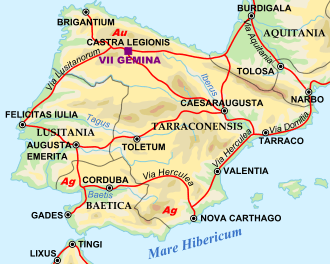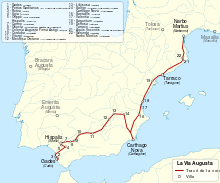Via Augusta


Via Augusta (also known as Via Herculea or Via Exterior) was a Roman road crossing all of Hispania Province, from Cádiz in the southern tip of current Spain, to the Coll de Panissars, where it crossed the Pyrenees close to the Mediterranean Sea, and joined the Via Domitia. The road stretched around 1,500 kilometres (900 mi)), passing through the cities of Gades (Cádiz), Carthago Nova (Cartagena), Valentia (Valencia), Saguntum (Sagunto), Tarraco (Tarragona), Barcino (Barcelona), and Gerunda (Girona). It had branches passing through Hispalis (Seville) (where it joined the Via Lusitanorum), Corduba (Córdoba), and Emerita Augusta (Mérida). The road was named after Emperor Augustus, who ordered it renovated between 8 BC and 2 BC. It was mainly a commercial road. Its path is currently followed by the N-340 road and the A-7 highway. North of Tarragona there remains a Roman Triumphal arch, the Arc de Berà, around which the road divides. At Martorell, the ancient Via crosses the river Llobregat on the Pont del Diable which dates from the High Middle Ages (1289 CE) in its current form.
Background Information
Just like there were important roads in the heart of the Roman Empire, their roads extended to the far corners throughout it. Once the Roman Empire had conquered Hispania, they, just like in the other territories, began to build roads. One of the popular sayings is that “all roads lead to Rome” and in a way that is true. Hispania, also called Iberia or the Iberian Peninsula, is home to modern day Spain, Portugal, Andorra, and the most southern part of France.[1] In Hispania, there were important roads and one of the most important roads was Via Augusta.[2] When Augustus went to Spain between 16 and 13 BC, he saw that roads, one of them being the Via Augusta, were to be created.[3] The road was built by the army. Therefore, the road was named after him.
Throughout the many years, there have been periods where there have been villages to many people along the Via Augusta and then there were periods where they were hardly people at all.[4] It varied for years. This road also passed through the Guadalquivir valley near the southern part of Spain.[5] Around the late 409, barbarians had entered Hispania and there was no one to take care of the roads.[6] The Via Augusta began to decay. A year later in 410 AD, the Roman Empire fell. The notion to maintain the roads also fell. The Romans were so busy trying to save their own city that they didn’t have time to properly oversee the reconstruction of the roads.
References
- ↑ Simon Keay, “Recent Archaeological Work in Roman Iberia”, The Journal of Roman Studies, 93 (2003): 146.
- ↑ S. J. Keay, Roman Spain, (California: University of California Press, 1988) 49.
- ↑ The Cambridge Ancient History, Volume 10, ed. by Alan K. B, Edward C., Andrew L. (Cambridge: Cambridge University Press, 1996) 454.
- ↑ Karen Eva Carr, Vandals to Visigoths: Rural Settlement Patterns in Early Medieval Spain, (Chicago: University of Michigan Press, 2002), 146.
- ↑ Karen Eva Carr, Vandals to Visigoths: Rural Settlement Patterns in Early Medieval Spain, (Chicago: University of Michigan Press, 2002), 146.
- ↑ Karen Eva Carr, Vandals to Visigoths: Rural Settlement Patterns in Early Medieval Spain, (Chicago: University of Michigan Press, 2002), 146.